Photography by Kevin Merrey and Mark Game
It was 70 days into Reza Pakravan’s bicycle expedition from Norway to South Africa before he cracked. His body weak with a recent bout of malaria and severe food poisoning, Reza and his expedition partner, Steven Pawley, slogged through the Kenyan desert in 40°C temperatures, out of water and, eventually, out of stamina. Pakravan’s vision went black, and he collapsed. There’s only so much the human body can take.
With no other way out, he had to continue. Just to the next village, he told himself. Just 10 more miles. He started pedaling slowly on the dusty, rock-strewn desert track. Suddenly, several warriors from the local Samburu tribe ran beside him with wide smiles, excitedly following his bike, legs pumping. This act helped Pakravan continue for the next 3,000 miles of the journey to Cape Town, 10 miles at a time.
Listening to Pakravan share this story from his garden shed (or “adventure dungeon” as he calls it) on a drizzly London evening, a jumble of bikes and backpacks in the background, I can’t help but think his experience sounds like the scene from an action-packed blockbuster. This is understandable, as compelling storytelling is part of what Reza does best as an explorer, filmmaker, and writer whose adventures are available to watch on Prime Video, the Discovery Channel, Outside Television, and more. He has broken Guinness World Records, taken audiences to some of the world’s most dangerous borders, and produced documentaries about contemporary mysteries in a time where we romanticize the past ages of exploration.
But Reza isn’t just a great storyteller on camera—it’s an extension of his personality. I was fortunate to speak with him about what he learned from traveling the length of the Sahel region of Africa, why he left a successful career in finance to attend film school, and how The Adventures of Tintin comics were a major childhood influence. We also touched on what he uncovered during his latest project, a multi-part Discovery series called Hidden Frontiers: Arabia, and why purpose-driven exploration is so important. Enthusiastic, engaging, and passionate, Reza Pakravan is the person you want at your next dinner party or campfire gathering.

A Kenyan tribesman runs with Reza, encouraging him on the next leg of his journey from Nordkapp, Norway, to Cape Town, South Africa.
Give me your quick elevator pitch. Who is Reza Pakravan?
When I introduce myself, I always say it depends on who you’re asking. If you ask my mom, she thinks I’m unemployed [laughs]. But I’m an explorer and filmmaker, and how these two intertwine is a very simple thing. I make films about exploration and grand journeys, which have taken me to some of the far-flung corners of the planet, whether behind or in front of the camera.
At the beginning of my career, I started doing long-distance endurance journeys. Then, as my career started to evolve, I became more interested in documenting adventure and exploration with impact. It has always been purpose-driven, using exploration as a tool to add knowledge the world otherwise doesn’t know anything about. Whether it’s in an unexplored canyon in search of our ancient past or entering a tribal zone and shedding light on the problems that those tribes are facing, whatever I do has a very specific purpose.
I always say explorers are storytellers. They create stories that change our understanding of the world we live in. Whether you’re exploring the Arctic, working with a bunch of scientists, trying to solve climate issues, looking at it from an anthropological point of view, or traveling to places that no one has traveled, you bring back stories and share them with the rest of the world.
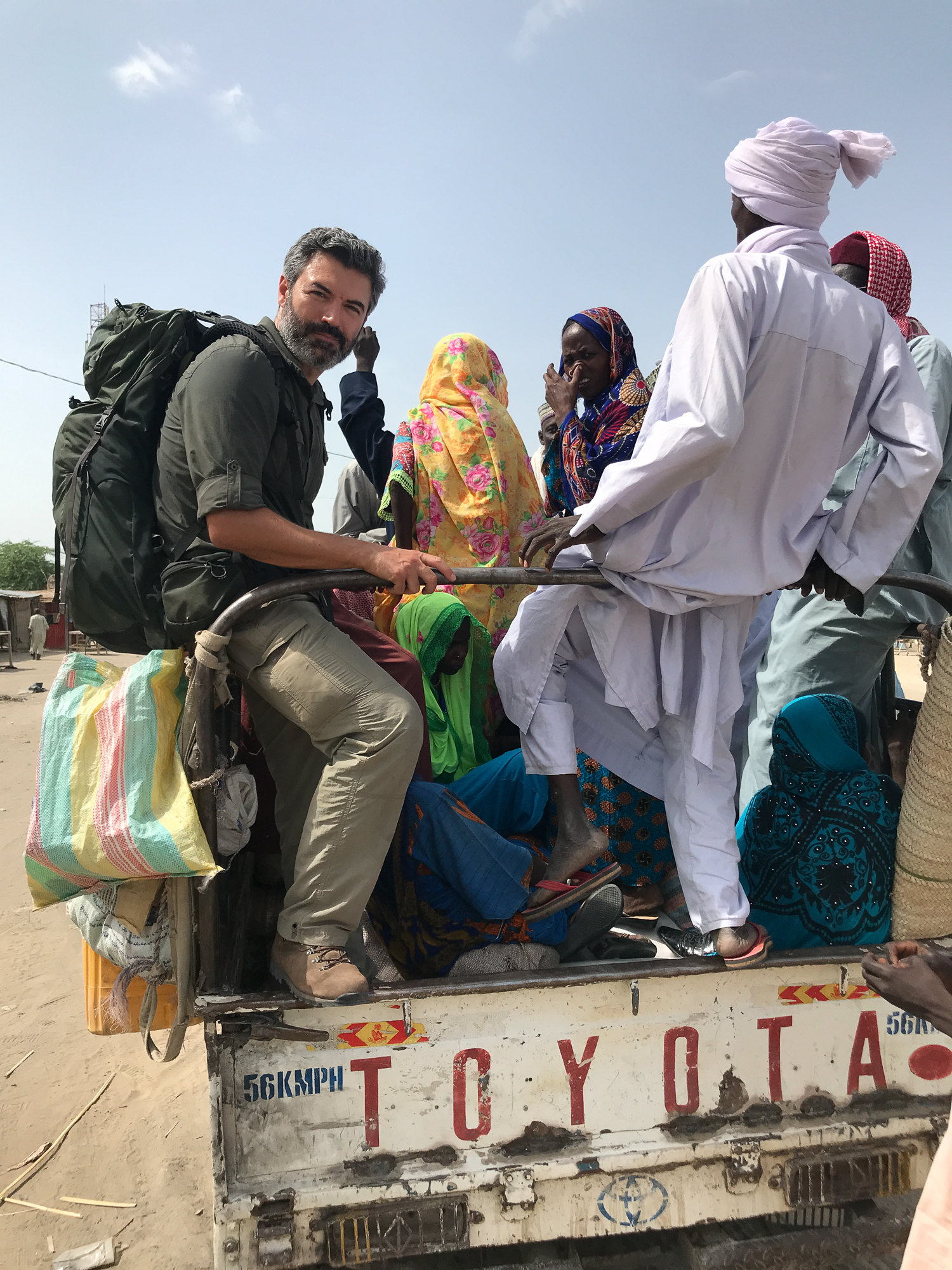
Getting a ride in Chad required relying on local trucks due to the absence of organized public transit.
How do you dream up ideas or concepts for expeditions?
They’re not ideas that I wake up with in the middle of the night and think, ‘Oh, I have to go to Papua New Guinea tomorrow.’ It’s not like that. Normally, I get obsessed with an idea or a region of the world, a mystery, something that we don’t know much about. A huge amount of knowledge acquisition takes place at the beginning, whether through contacts or the internet. I’m part of the Royal Geographical Society, the Explorers Club, and the Scientific Explorers Society. All of these have a network of individuals, well-traveled people with a very established international footprint. The first four or five months of my digging are basic knowledge acquisition, and then I refine that to an idea that I would like to present from that region of the world, this mystery that I want to solve.
What kind of information do you acquire from the membership organizations you just mentioned?
Let’s say I’m about to venture into the Sahelian belt in North Africa, for example. I would find people who have extensive knowledge about that place, papers published about that part of the world, or films. Journalists who have traveled there and NGOs who have penetrated that region can provide first-hand information because the majority of the regions are really, really remote and require specialist knowledge.
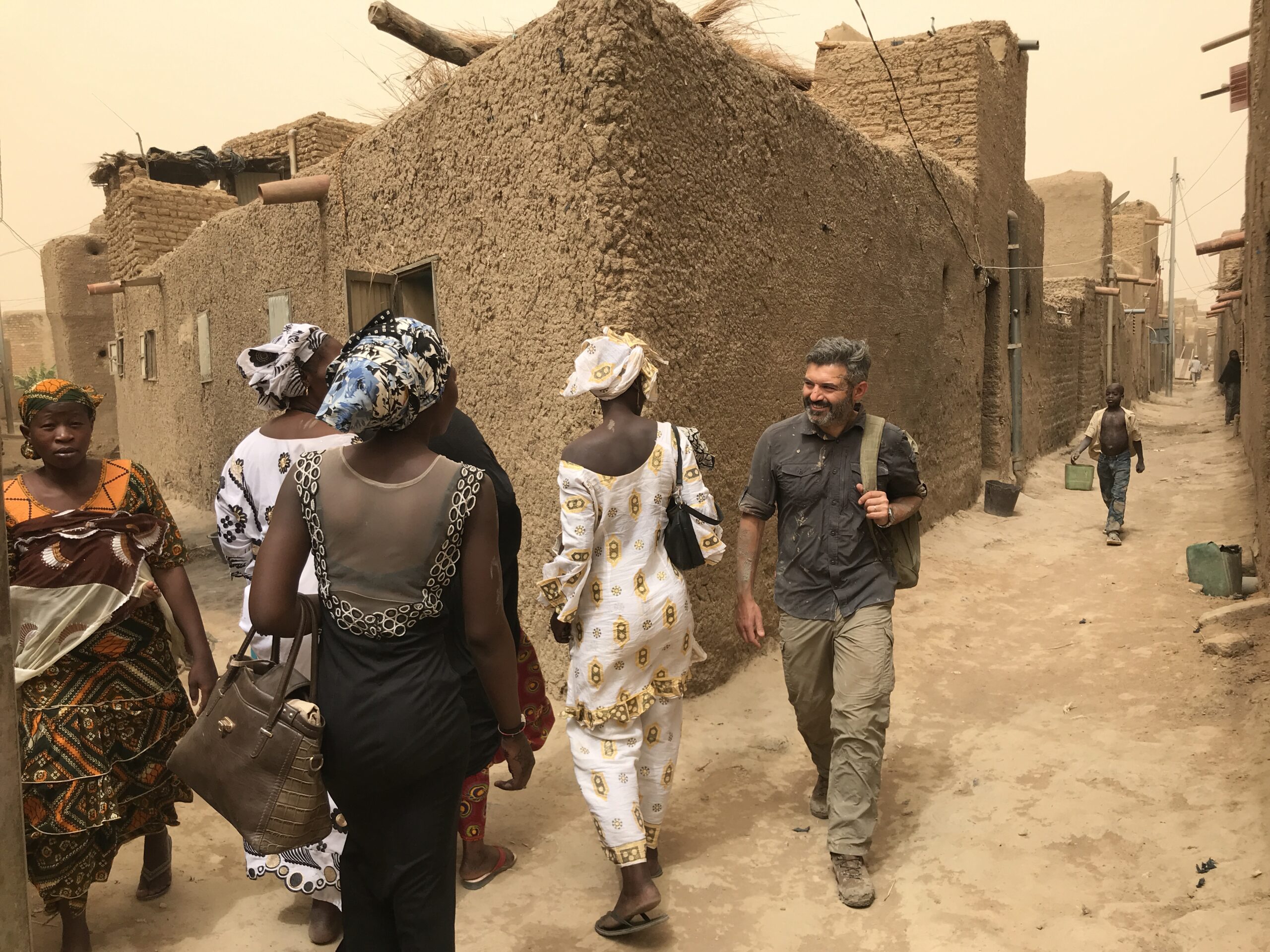
The streets of the ancient city of Djenné, Mali, said to be one of the oldest towns in sub-Saharan Africa.
What was your childhood like? Were you always interested in exploration, research, and filmmaking?
I was born in Iran. During my childhood, I remember just war and revolution. The country was quite closed to the rest of the world, so all we had available to us, and my window to the outside world, was Tintin, [from] the illustration book by Hergé, the Belgian writer.
My mum and dad worked hard in [the] television [industry] for not much money. At the beginning of my career, I traveled with my dad internationally and domestically. He was making documentaries, and whenever it was possible, he took me with him. I picked up a camera when I was 10, so I knew how to edit by the age of 15. In those days, it wasn’t digital; it was 16- or 35-millimeter film. We were in the US in those days. I got to 16 or 17 and said, I know better. I would go to London and study finance, make loads of money, and prove them wrong.
We’d always lived at the edge of the mountain, so my childhood had been outdoors—skiing, mountain climbing, trekking, and all that kind of stuff. When I came to London, it was a bit of a shock to the system. Entering the strange world of finance, which was completely different to every fabric of my being, was very attractive in the beginning. The money was great. In two years, I paid all my student loans. Those were the glorious days of finance. You know, money, girls, cars, excitement. And honestly, I could afford everything I wanted. A single guy in your mid-20s in London working in finance. What’s not to like?
Fastforward years later, I was overweight, sitting in a corporate office completely depressed and resorting to [expletive] loads of alcohol, which is part and parcel of working in finance. That’s the only thing that makes life bearable. One day, I was walking over London Bridge, and I just told myself this wasn’t the life I wanted to live. It took me about three years to be able to transform my life, to do something that I really wanted to do.

The Dogon wear more than 60 different masks that represent animals, people, and spiritual beings.
That meant quitting everything and starting film school in San Francisco. How was the transition?
It wasn’t plain sailing. It was very, very difficult. Going from a six-figure salary, with all those corporate perks and lovely apartments in the best part of town, to, all of a sudden, becoming homeless. I spent all my savings on film school to learn a craft from scratch. I spent a good part of 18 months couch-surfing on people’s sofas.
How did you go from working in finance and studying at film school to undertaking a Guinness World Record expedition across the Sahara Desert?
When I was still in finance, I was an office worker without much confidence about the stuff I wanted to do. I thought, What skills do I have that I can actually offer? I’m not an Arctic explorer; I don’t have any amazing genetic makeup; I’m not the strongest, fastest, or toughest. So, I looked around the house. I used to do a lot of mountain biking. I started doing, incrementally, let’s say, a day ride to a weekend ride and then combined it with camping. I started developing my skills, wild camping, and a bit of outdoor stuff. I began to claw back all the things I had from childhood. It was all there. Little by little, I picked up the camera again. I got to the stage where I had the confidence to set off on a big expedition, so I decided to cross the Sahara Desert by bicycle. I applied for the Guinness World Record, and they set up criteria and gave me a time limit to do that. I did that journey, and it changed my life completely. When I came back, I remember the moment I put my key in the keyhole and opened the door, and something hit me: What’s next?

Behind the scenes of Hidden Frontiers Arabia, Iraqi Kurdistan.
Two years later, you embarked on a bicycle journey from Nordkapp, Norway, to Cape Town, South Africa, in a record time of 102 days. How did this experience impact your career as a filmmaker?
Whatever I learned in film school, I put into practice. I was filming the journey and mobilized a group of people who joined me here and there to film. Before the series was sold, I had to endure a huge amount of physical and financial hardship. It was intense. Then, during the expedition, I got malaria and food poisoning along the way. It was a race against time to get to Cape Town, an eternal state of torture. But we created this independent television series, managed to find distribution, and sold it. Then I got a book deal. Kapp to Cape was published by Summersdale, and all of a sudden, life changed. I started doing more and more and was employed to film other people’s expeditions for mainstream channels.
In 2016, you undertook a 4,000-mile journey across the Amazon Rainforest, documenting environmental crimes and their impact on local indigenous tribes. What were your takeaways from this experience?
I spent a lot of time with people with the least amount of contact with the outside world and learned about how their lives came to danger by outside forces—whether by cattle ranchers, gold miners, environmental destruction, and so on. I had the pleasure of traveling to the edge of the territory of uncontacted tribes and seeing things very few in the world have ever seen.
It was a very interesting experience because you see people who don’t understand the value of money. The monetary world that we know, for them, isn’t comprehendible. They come into contact with the outside world because they see loggers or poachers using modern goods. They come to the outside world thinking they can have those goods. Think about it—how would you feel if you lived in a tiny village all your life and then they transferred you right to the middle of New York City? Very overwhelmed. For them, it’s like 100 times more. On that basis, they enter this emotional anxiety, and there is no mechanism for them to feel better.
I was deep in the Amazon for three months and spent six weeks in a primary forest studying the people, who were pretty much hunter-gatherers. They move through the jungle without leaving any trace. After the expedition finished, I went to Machu Picchu with my wife, and it was the biggest shock to the system. I didn’t enjoy it. All of a sudden, I saw millions of tourists pouring down to Machu Picchu with cameras. I would probably enjoy it in any normal circumstances, but then I was in a completely different mindset.

The annual fshing ritual of the the Munduruku community in the Brazilian Amazon centers around the use of crushed venomous roots.
The World’s Most Dangerous Borders series took you to the Sahel region of Africa. What is the significance of this area?
The Sahel is a narrow belt sandwiched between the arid Sahara Desert and the fertile savanna, connecting West and East Africa and running from Senegal to Somalia. It’s a transition area that separates nomadic life and settlements. My journey, and the title of the series, was about why these borders are the most dangerous in the world.
I went on two recces before starting the journey. The first time I went to Chad, and what I saw literally blew my mind. I had traveled to about 80 countries by then, and I’d never seen a place like Chad or Niger. These are the poorest countries in the world by far margin, and they have not been developed in many shapes and forms. When traveling there, you feel like you’ve gone back 100 years.
I started my journey in Senegal, which is quite stable, and made my way to Mali. It’s such a spectacular, incredibly culture-rich, beating heart of West Africa. But the country is in trouble, as is the rest of the Sahelian region. There is really only one reason. Due to global warming, the Sahelian belt is shrinking daily, leading to massive desertification and pushing the desert further down. Many communities in the north find their resources dwindling, and they have to migrate further south. But they have a minimum amount of resources south of the Sahelian belt. That’s why there’s a climate war and such devastation and poverty.

Reza participates in a Zār ceremony in Sudan, which involves mediation between spirits and their human host.
Tell us about border crossing logistics during the filming of The World’s Most Dangerous Borders.
There’s one word to describe it: a nightmare. I have to say, between all those border crossings, there was just one easy one, and it was Senegal to Mali. The rest were the most painful border crossings ever. The worst one was passing to Sudan from Chad. That led us to spend four days in jail, where we were held by Sudanese intelligence services.
Was your entire team and film crew held in prison?
Yes. We were in Chad and wanted to get to Sudan, but we were in such remote places that we didn’t know what was going on in the world. While we were trying to film this incredibly beautiful tribe in the middle of nowhere, a revolution was happening in Sudan. By the time we got to the Sudanese border, the government had already been toppled, the army had taken over, and the border we wanted to cross was a very politically sensitive place. Not a single camera crew over the last 20 years has been able to pass through, and we had special permission. As we got there, we didn’t know [about the revolution]. They told us there was no arrangement. We crossed the border and were taken to the barracks, handed over to intelligence, and were in jail for four days before we were kicked out of Darfur and sent to Khartoum, the capital, for further questioning.
What was your Sudanese prison experience like?
They were respectful. The Sudanese are nice people. The only problem was sanitary—the toilets were disgusting. The smell was so overpowering we couldn’t sleep. I’ve been to a few bad places with a lack of hygiene and bad toilets, but this was on a new level. My cameraman got salmonella and was vomiting. On the last day, when they put us on a United Nations flight, we were so happy and relieved. At the time I was in custody, my wife was pregnant back home, so she didn’t hear from me for four days.

Every year, residents of central Mali gather to replaster Djenné’s Great Mosque. This event, called the Crépissage, celebrates community, faith, and heritage.
Take us behind the scenes of your latest series, Hidden Frontiers Arabia. What did the preparation look like?
It took us about a year to put it together. There are not many places in the world left that people say, ‘This place is really unexplored.’ Fortunately, Saudi Arabia just opened its doors after hundreds of years of being closed to the rest of the world. After a few recces and a lot of studies, we realized there are a few mysteries to unlock. For example, in Iraqi Kurdistan, there’s this endangered species, like a Persian leopard, that thrives within minefields. There are only 20 of them left in Kurdistan.
These are politically sensitive countries, so when we approached them to get film permits, it was incredibly difficult because they thought we wanted to report on human rights. We create adventure television, so that wasn’t the purpose of the show. Just getting a drone permit was a nightmare. Anyhow, we got through all of that and wanted to put together six stories. One was in Iraqi Kurdistan, which was the Persian leopard—a big mystery. How do we find this endangered, nearly extinct species? The second was an unexplored canyon in Saudi Arabia. In Oman, we found the potential existence of life in an impenetrable converging canyon system—that was another mystery. No one has filmed dugongs (sea cows) in the Persian Gulf because they are very skittish, but we were the first to capture them on camera. Another one was finding a tribe living in one of the driest places in the world without any sort of water; we wanted to know how they do it.
From road to fat bikes, you’ve completed many journeys by bicycle. Do you have any favorites? Do four-wheeled vehicles make an entrance from time to time?
I have to say fat bikes are not my favorite. I used a fat bike to cross the desert in Saudi Arabia, and it was so heavy and hard on the legs and body. Obviously, we had to deflate the tires to get a bit of friction, but you push hard, and there’s not much progress. But that was the only way to cross vast sections of sand dunes and desert in this development called Neom in Saudi Arabia.
In other episodes, we used the Land Cruiser. I really like it. In fact, when we wanted to go to one of the caves, because we didn’t have any anchor point, we wrapped ropes around the car and used it as an anchor when we were descending into a sinkhole.
But in terms of traveling, I never forget the times I had with my expedition bike. For many years, I’ve been sponsored by Koga, a Dutch brand, and they make the best travel bikes ever. I normally travel with fully laden bikes—you know, two panniers in front and two in the back with a dry bag strapped around the back of the bike, carrying 35 kilos with everything I need. I miss that. That was one of my best memories, to think, to have done my daily quota, stop and start a fire, get the stove going, cook whatever I needed to, and enjoy the moment of silence and peace.
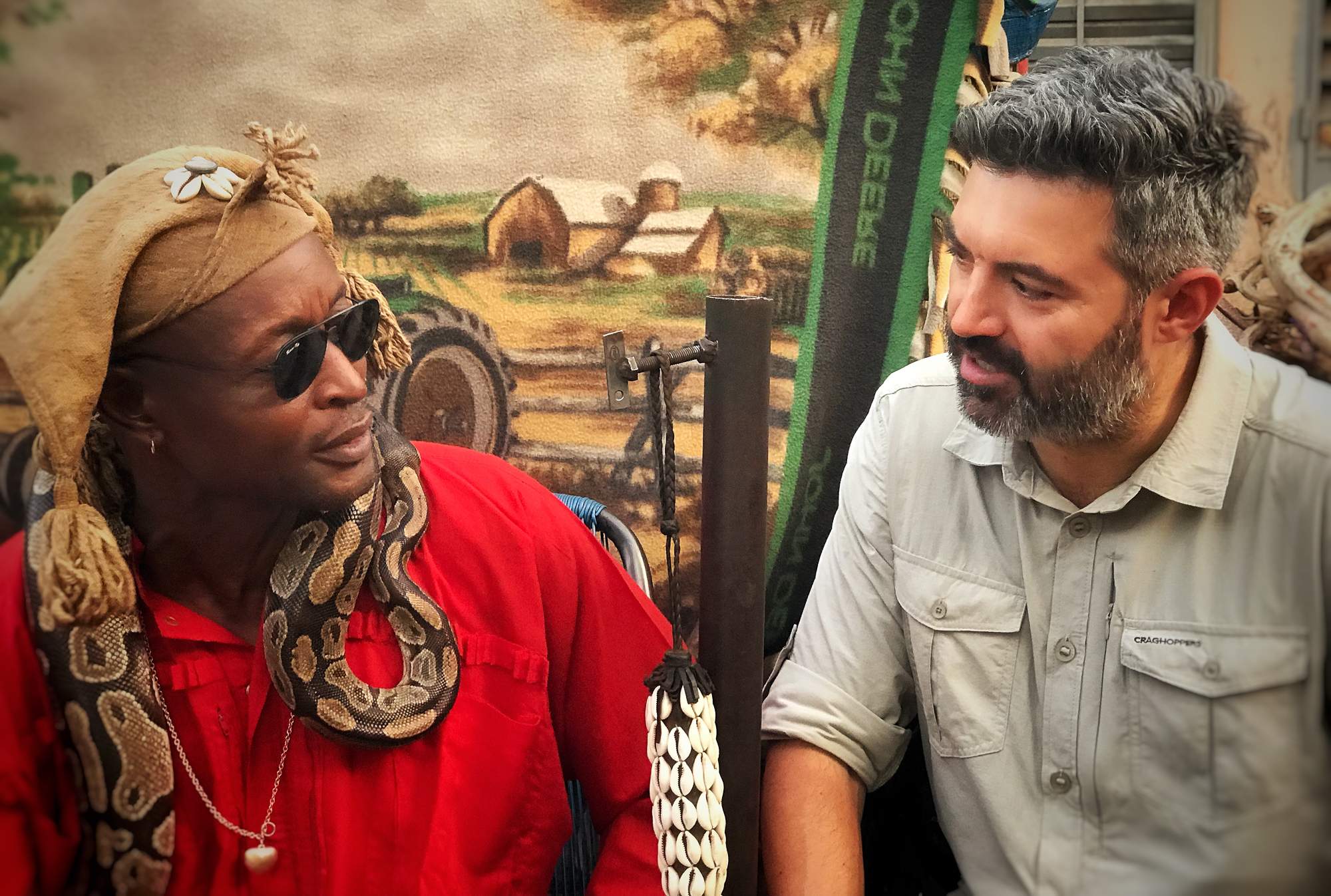
Meeting a shaman in Mali, while flming The World’s Most Dangerous Borders series.
Let’s bridge the gap between your trips and your daily life because I think you have a lot of advice to share and tips and tricks to give.
I can list all of that for you, but that’s not a sincere answer. I struggle with normal life. That’s a very honest, heartfelt answer because I spent the last 14 years of my life traveling non-stop. I was away from the UK on filming trips about four to five months a year, constantly on the road. Coming from Papua New Guinea, I packed my bag, and three days later, I was in the Arctic or the Amazon. I cannot be on the road as much as I want to, especially because I’m running a small company and have a little one now. As much as I love my family, that mundane grind is a real struggle. To make it a little bit easier, I do a lot of rock climbing.
What is your favorite book?
Sir Richard Burton is my inspirational hero. I read all of his books and absolutely adore this man. His famous quote says, ‘Of the gladdest moments in human life, methinks, is the departure upon a distant journey into unknown lands.’ This has stayed with me always. The moment I sit on the plane is one of the happiest moments of my life.
But my favorite book is First Footsteps in East Africa by Richard Burton. It’s the rawness of travel in those days. He traveled to the wilderness of East Africa with the bare minimum to find a lake [Tanganyika]. You know, nowadays, doing that trip is not a big deal, but in those days, his were the first footsteps by a white man going into the African wilderness without any maps or much knowledge. How do you navigate that? He was an incredible individual. It was quite different in those days, wasn’t it? It was about going to new places. These days, it’s not about going to new places but your take on those places and your travels.
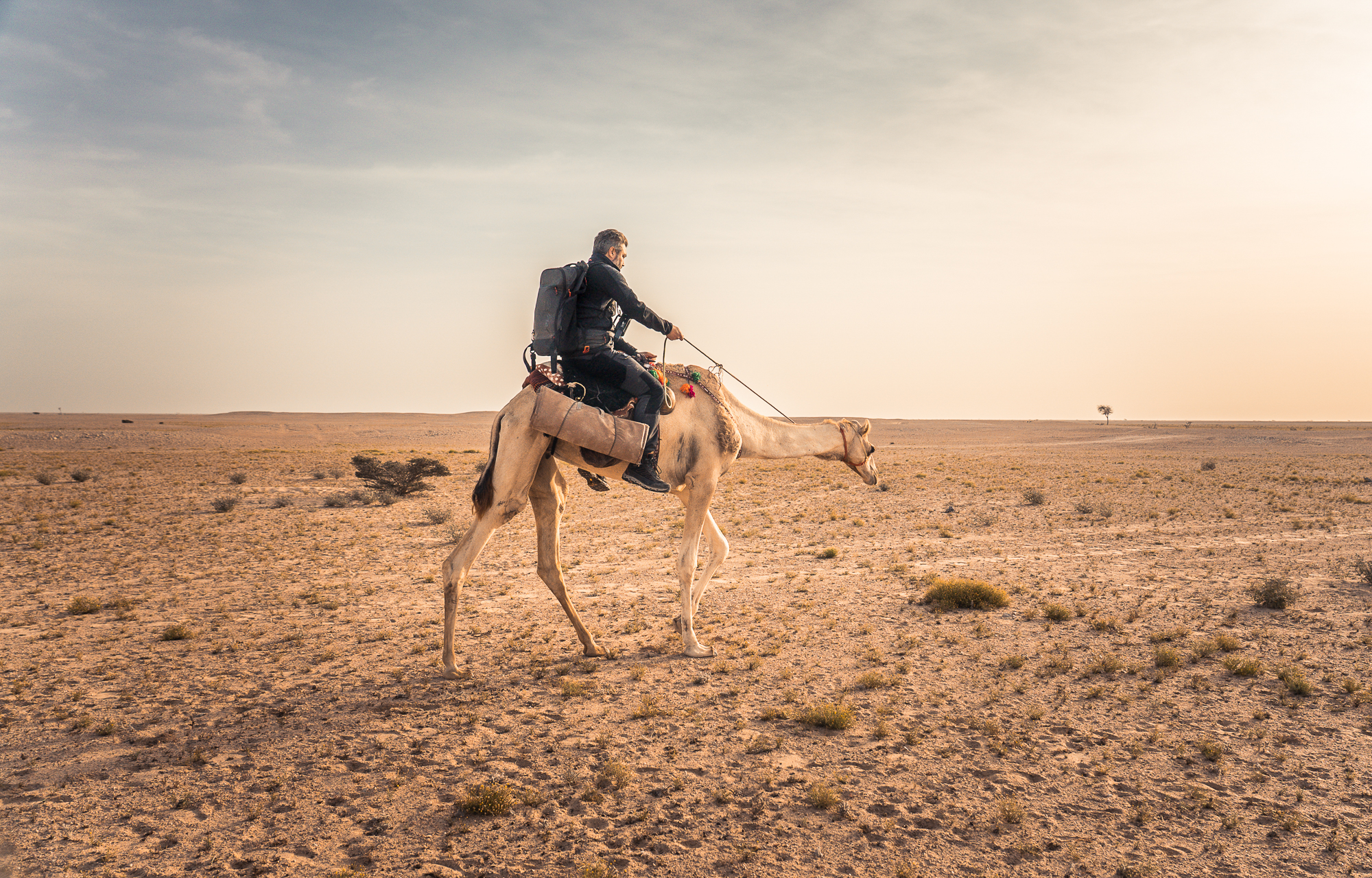

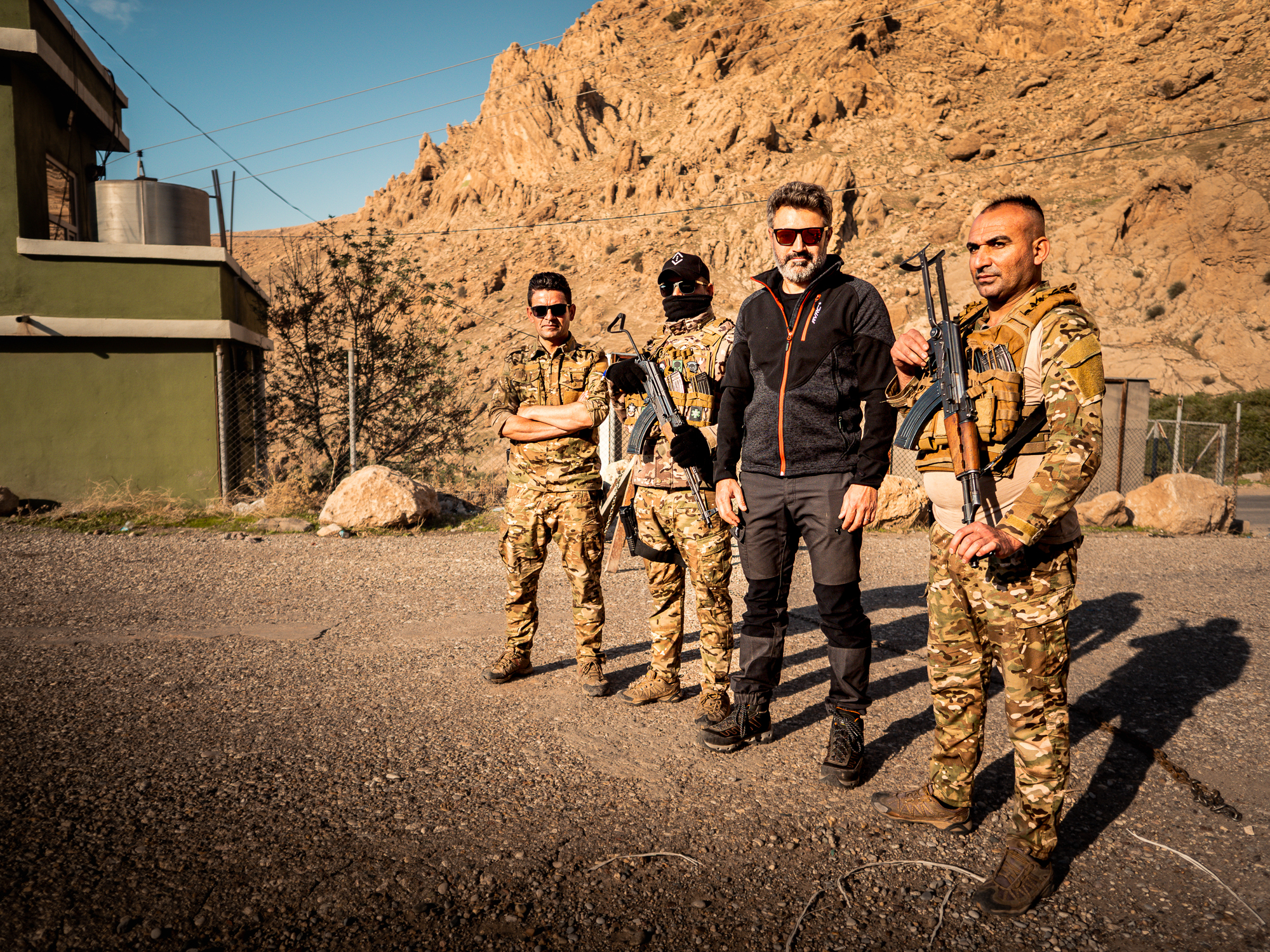
For more about Reza Pakravan, please enjoy Episode 174 of the Overland Journal Podcast.
Editor’s Note: This article was originally published in Overland Journal’s Summer 2024 Issue.
Our No Compromise Clause: We do not accept advertorial content or allow advertising to influence our coverage, and our contributors are guaranteed editorial independence. Overland International may earn a small commission from affiliate links included in this article. We appreciate your support.


